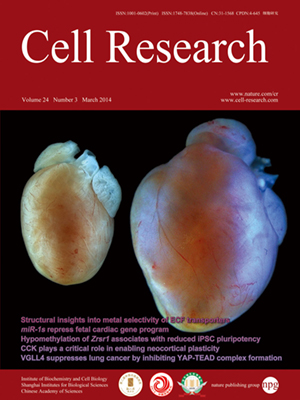
Volume 24, No 3, Mar 2014
ISSN: 1001-0602
EISSN: 1748-7838 2018
impact factor 17.848*
(Clarivate Analytics, 2019)
Volume 24 Issue 3, March 2014: 278-292
ORIGINAL ARTICLES
Multifaceted roles of miR-1s in repressing the fetal gene program in the heart
Yusheng Wei1,5,*, Siwu Peng1,*, Meng Wu1, Ravi Sachidanandam2, Zhidong Tu2, Shihong Zhang3, Christine Falce4, Eric A Sobie4, Djamel Lebeche3 and Yong Zhao1
1Mindich Child Health and Development Institute, Department of Genetics and Genomic Sciences, Icahn School of Medicine at Mount Sinai, One Gustave L. Levy Place, Box 1040, New York, NY 10029, USA
2Institute for Genomics and Multiscale Biology, Icahn School of Medicine at Mount Sinai, One Gustave L. Levy Place, New York, NY 10029, USA
3Cardiovascular Institute, Icahn School of Medicine at Mount Sinai, One Gustave L. Levy Place, New York, NY 10029, USA
4Pharmacology and Systems Therapeutics, Icahn School of Medicine at Mount Sinai, One Gustave L. Levy Place, New York, NY 10029, USA
5Current address: College of Life Sciences, Peking University, Beijing 100871, China
Correspondence: Yong Zhao, Tel: 1-212-824-8916; Fax: 1-212-241-3310(yong.zhao@mssm.edu)
miRNAs are an important class of regulators that play roles in cellular homeostasis and disease. Muscle-specific miRNAs, miR-1-1 and miR-1-2, have been found to play important roles in regulating cell proliferation and cardiac function. Redundancy between miR-1-1 and miR-1-2 has previously impeded a full understanding of their roles in vivo. To determine how miR-1s regulate cardiac function in vivo, we generated mice lacking miR-1-1 and miR-1-2 without affecting nearby genes. miR-1 double knockout (miR-1 dKO) mice were viable and not significantly different from wild-type controls at postnatal day 2.5. Thereafter, all miR-1 dKO mice developed dilated cardiomyopathy (DCM) and died before P17. Massively parallel sequencing showed that a large portion of upregulated genes after deletion of miR-1s is associated with the cardiac fetal gene program including cell proliferation, glycolysis, glycogenesis, and fetal sarcomere-associated genes. Consistent with gene profiling, glycogen content and glycolytic rates were significantly increased in miR-1 dKO mice. Estrogen-related Receptor β (Errβ) was identified as a direct target of miR-1, which can regulate glycolysis, glycogenesis, and the expression of sarcomeric proteins. Cardiac-specific overexpression of Errβ led to glycogen storage, cardiac dilation, and sudden cardiac death around 3-4 weeks of age. We conclude that miR-1 and its primary target Errβ act together to regulate the transition from prenatal to neonatal stages by repressing the cardiac fetal gene program. Loss of this regulation leads to a neonatal DCM.
10.1038/cr.2014.12
FULL TEXT | PDF
Browse 2265


